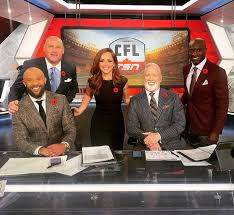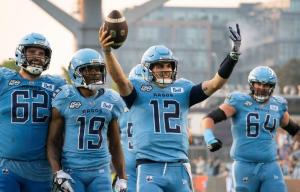One need not search long or hard on social media to find offensive commentary as it relates to female athletes and sports. Misogyny is as common as prayer in a church.
It is, in fact, the reason I ceased interacting on Twitter.
After I had mentioned the CFL on TSN football panel in a tweet last August, a reader responded with disgusting, degrading and sexist bile about host Kate Beirness, who does boffo work attempting to harness the egos of the “experts” sitting beside her in the studio.
I’ll spare you the gory details, but suffice to say it was gross and, although I know Kate only via my flatscreen, I wasn’t prepared to allow a character assassination on my feed. Thus, I deleted the crude comment and have since refrained from engaging in banter on Elon Musk’s play thing.
But what about sexism in mainstream media?
There are different levels of discrimination based on gender, like the extreme, gawdawful examples we easily find on social media, whereby female athletes are reminded that they belong in the kitchen or barefoot in the bedroom. Or it can be the subtle sexism that we find in our newspapers and on our air every day.
Damien Cox tapped into that very thing in a recent essay for the Toronto Star, noting the ocean-wide gap between coverage of the recent goings-on in the National Hockey League and glad tidings of a women’s super league. Between the NHL Entry Draft, the swapping of sweaters and Free Agent Frenzy, an entire forest worth of newsprint was required to accommodate daily dispatches on the men, whereas the biggest story in the history of Ponytail Puck was limited to “oh, by the way” acknowledgment.
“Do we know why this patriarchy still exists?” Cox asked. “Of course we do. It’s about money, and it’s about the way in which women’s pro sports have long been perceived in the North American sports culture.”
Cox also submitted this gem about coverage of male/female sports: “It certainly seems acutely unbalanced”
Yikes! It seems unbalanced?
That’s like saying Donald Trump’s legal team seems to have a lot on its plate these days.
I mean, numerous studies tell us that female sports receives less than 10 per cent of print/air time and, in the 30 years from 1989 to 2019, the needle didn’t move in a favorable direction for the women on TV.
“News organizations spend a lot of money researching what their customers are interested in,” Cox writes. “The clicks tell all.”
No. They don’t. Neither does money.
There’s one basic reason why female athletes don’t sit at the big table and eat with the grownups—mainstream sports media chooses to keep them at the kids’ table.
Too many editors remain locked into the horse-and-buggy thinking of the 20th century, a time when a female athlete was oft looked upon as freakish and sports writers weren’t shy about reminding them of their “proper place.”
For example, this is what Joe Williams of the New York World-Telegram wrote about Olympic and golf champion Babe Didrikson Zaharias, aka the Texas Tomboy: “It would be much better if she and her ilk stayed at home, got themselves prettied up and waited for the phone to ring.”
Williams also had this to say about Babe’s skill level: “The same year she became the greatest woman athlete in history, a comparative chart showed that she had not equaled one record made by a masculine high school champion of the same period. If the best woman athlete in the country is not as good as some gawky kid in high school, why waste the effort, why invite the embarrassment of mediocrity, why—well, why not get a seat in the stands and make the big male blokes out there on the cinder track believe you are nuts about them?”
Does that sound familiar? Sure does. We hear the same refrain today about the Canadian and American national soccer and shinny sides—they can’t beat teenage boys, so they’re either ignored or banished to the back pages of newspapers and the back half of sports highlight shows.
But, again, someone makes the choice to designate female athletes as back-page material. And that someone is most likely male.
Results from a study of 100 newspapers and websites by the Institute for Diversity and Ethics in Sport (TIDES) in 2021 showed the following:
Only 16.7% of sports editors were female.
Only 24.2% of assistant sports editors were female.
Only 19.3% of sports staffs were female.
Only 17.8% of sports columnists were female.
Only 14.4% or sports reporters were female.
Only 24.7% of copy editors/page designers were female.
If we use Good Ol’ Hometown as an e.g., we find that neither the Winnipeg Sun nor the Winnipeg Free Press has a female sports scribe or editor on staff. Zero.
The tabloid’s coverage of women is basically non-existent, while the broadsheet’s record on the female file is a study in neglect, most notably as it relates to local athletes. Although the Sun has ceded the female field to the Drab Slab, the Freep has delivered just 126 articles/briefs exclusive to local female sports in the opening half of 2023. That’s an average of 21 per month. Since the curling season ended, the average is 10 per month. Or one article/brief every third day.
Overall, the Freep published 2,143 articles/briefs exclusive to male athletes January through June, compared to just 394 on women (monthly average: 357-65).
Again, this isn’t down to market research, money or Internet clicks. It’s down to choice.
Every day in every newsroom there’s an editor making the call on copy—what stories to run, what goes on the sports front and what’s relegated to the inside pages. Ideally, they do so based on the significance and/or quality of an article, except the significance and/or quality is often devalued by an antiquated, prevailing and built-in gender bias that too often comes into play. Thus, editors and their scribes choose not to chase down good stories on female athletes.
Perhaps it’s become a subconscious thing, but it’s very real, and it’s the North America norm.
Damien Cox is absolutely correct when he suggests coverage of NHL affairs vs. the landmark news in women’s hockey is “a snapshot of where we are as a sports media culture.”
The avenue to changing that isn’t necessarily getting more women involved in sports media, although that would be a refreshing development. It’s getting the men in sports media to change their outdated perceptions. An attitude adjustment, if you will.
You know, time was when the most stinging insult on the playground was one boy telling another lad “You throw like a girl” or “You run like a girl.” It was the go-to put-down that no boy yearned to hear (trash talk before it was called trash talk). Yet that’s exactly what mainstream sports media is saying in its allotment of space/time to female athletes: “We won’t waste time and space on them because the throw and run like girls.”
While it’s true that Connor McDavid can skate circles around Marie-Philip Poulin, that doesn’t mean editors and writers should reduce her to an after-thought or, worse, ignore her. There’s considerable value in what she does, and the same must be said for a lengthy roster of female athletes, from the sandlots to the citadels of sports.
All female athletes have a tale to tell and they aren’t hard to find. Perhaps editors/scribes are too lazy or too indifferent to go after them, but I say it’s because they’re too entrenched in 20th-century twaddle.
That isn’t just sad, it’s malpractice.
It’s interesting that Cox would wax on about the discrepancy in male/female coverage, because just last October this headline appeared in the Toronto Star, above a column by Donovan Vincent, the paper’s Public Editor: “Women still under-represented in Star’s sports coverage.” Has anything changed in the ensuing eight months? Well, there was a sports front piece on teenage girl skateboarder and Olympic hopeful Fay De Fazio Ebert in Saturday’s edition, and it was written by a female scribe, Kerry Gillespie, so that’s encouraging. Like I said, the stories are there. All it takes is an editor and/or writer who chooses to tell the tale, and all those almighty Internet clicks be damned.
Mike O’Shea had no business coaching the Winnipeg Blue Bombers after his first two whirls as sideline steward. The guy was 12-24 and couldn’t have been less popular if he’d put on a Saskatchewan Roughriders jersey, swilled cans of Pilsner and led a Gang Green rally before the Banjo Bowl. Townfolk embraced him the way they do spring flooding. But just look at Coach Grunge now. Winnipeg FC’s 24-11 success over the Calgary Stampeders on Friday night was his 86th regular season W, putting him in lockstep with legend Cal Murphy and 16 in arrears of legend Bud Grant. Add to that two Grey Cup championships, plus twin Canadian Football League coach-of-the-year salutes, and it places him in pigeon perch territory. Oh, yes, like both Murphy and Grant, there shall be a statue of O’Shea outside the Football Field In Fort Garry one day, although they’ll have to put the sculptor on hold since Coach Grunge has no plans to skip town anytime soon. And if they do it right, he’ll be chiseled in short pants, a t-shirt and a tattered ball cap.
Jim Barker was correct: The Bombers-Stamps skirmish was a “slobber-knocker.” Or, as old friend young Eddie Tait would say, “snot bubbles” were the order of the day. When Vince Lombardi called football a “collision” sport, this is what he was talking about. The lads put on their big-boy pants and really had at it. It was a demolition derby in cleats.
So sad to see what’s become of the Edmonton Elks, the one-time flagship franchise of Rouge Football. I’m not sure the Elks still have a pulse, with zero Ws this season (0-5), zero Ws on home soil since October 2019 and more empty seats than a canceled Taylor Swift concert. The great mystery isn’t when they’ll finally win again at Commonwealth Stadium, it’s will head coach Chris Jones will be on the sideline when it happens.
I don’t know about you, but I liked the Toronto Argos better when they wore Double Blue unis, not the robin eggshell togs they’re sporting this season.
Who’s responsible for the 2023 Rouge Football schedule? We’re only a month in and the Argos are already on their second bye week. Not that anyone in the Republic of Tranna will notice. The Boatman attracted just 12,473 of 8 million locals to their last frolic at BMO Field. And, to think, they won the Grey Grail just seven months ago. Pitiful, just pitiful.
Bet you didn’t know that the Snail Racing World Championship was held Saturday at the Grimston Cricket Club in Congham, England. True story. The snails slow-poke their way to the finish line in a 13-inch race, and the world record for snail-level lickety-split is two minutes flat, established in 1995 by Archie, thereafter known as the Escargot Express. No word on whether or not Archie was last seen as an appetizer on a Frenchman’s dinner plate.
That mention of escargot brings to mind one of my favourite all-time sports quotes, from former Major League Baseball player and coach Rocky Bridges, who, when asked why he refused to eat snails, said: “I prefer fast foods.”
On the subject of edibles, no surprise that the king of gluttony, Joey Chestnut, successfully defended his Nathan’s Famous International Hot Dog pigout title after a lengthy rain delay last week on Coney Island. But Joey was off his game in retaining the coveted Mustard Belt, scarfing down just 62 tube steaks in 10 minutes, well off his personal best of 76. Just wondering: How many snails do you suppose Joey could inhale in 10 minutes?
Not impressed with the Chestnut tube steak chow-down was ESPN’s Stephen A. Smith. “It’s nasty as shit,” Smith said. “His significant other does not want to be around him for the next few days. It’s gonna be a lot of gas passed. It’s a lot of gas. I know ’cause I don’t eat hot dogs like that and I pass gas sometimes. Stay away from me. I don’t want to meet you. You might burp and I might smell it from a mile away. I don’t need that in my life. No, no, no.” And, hey, if anyone ought to know about gasbags, it’s Stephen A.
Observations through week one of Wimbledon: Our guy Milos Raonic plays like he’s bored out of his mind, and another one of our guys, Denis Shapovalov, might be the biggest crybaby on the men’s side.
The Premier Hockey Federation had 121 players under contract for a season that will never happen now that Mark and Kimbra Walter have bought women’s hockey lock, stock and ponytail, and I’m still waiting for the other skate to drop. I mean, surely some PHFers are royally PO’d, knowing they’ll never draw another paycheque through no fault of their own, and I can’t believe they’re prepared to slink away without a squawk. Once the Walters, Stan Kasten and Billie Jean King reveal the details of their successful Coup de Shinny, I have a suspicion we’ll finally hear some fallout and the voices will be loud.
And, finally, when did Marc Liegghio get a bionic leg? I mean, seven months ago he couldn’t kick a can on the street let alone a football, and it cost the Bombers a third successive Grey Cup title. Yet there he was on Saturday night hoofing five field goals to push the Hamilton Tabbies past the Bytown RedBlacks. Go figure.








You must be logged in to post a comment.